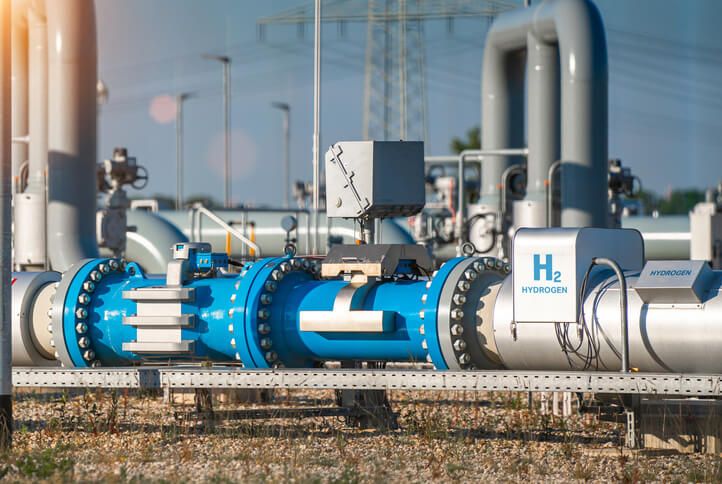Hydrogen Trends Fueling the Alternative Energy Market: 2023 Edition

As the most abundant known element in the universe, hydrogen promises efficient, clean energy that produces no direct emissions of pollutants or greenhouse gases. Hydrogen trends show that this renewable energy source has become widespread in transportation, manufacturing and power generation sectors.
The global hydrogen generation market is expected to grow from $160.0 billion in 2022 to $263.5 billion by 2027. In addition, the demand for fuel cell electric vehicles (FCEVs) and rockets in the aerospace industry is also driving market growth.
Today, we’ll review eight hydrogen industry trends fueling the alternative energy movement in 2023.
1. Inflation Reduction Act Spurs Alternative Energy Growth
President Joe Biden signed the Inflation Reduction Act of 2022 into law in August 2022. Also known as the U.S. Climate Bill, this law promises to invest about $370 billion to reach international climate goals, including reducing greenhouse gas emissions 40 percent by 2030.
The law’s primary investments lean toward energy and climate measures, including:
- Investments in low-carbon energy
- Residential tax credits for low-emissions technologies
- Tax credits to encourage low-emission and electric vehicle purchases
- Commercial tax credits for domestic clean energy technologies
2. EPC Contractors Streamline Alternative Fueling Projects
Expanding hydrogen infrastructure is critical in making alternative fuels available for commercial and public use. Rather than hiring separate contractors for projects, companies building refueling stations are relying on end-to-end EPC (engineering, procurement and construction) contractors to streamline infrastructure projects.
FASTECH specializes in EPC+M, adding maintenance services that help refueling facilities keep equipment up-to-date with testing and compliance requirements.
3. Cities Are Transitioning to Clean Energy Solutions
While many urban areas are creating large carbon footprints, some cities are taking a new approach by moving away from fossil fuels. Here are some strategies that cities are incorporating in their transitions.
- Legislation, policies and deals are paving the way for increased alternative energy infrastructure
- Generating power off-site and transporting it within city limits
- Shifting public vehicles to electric, hybrid, CNG, propane and biodiesel fueling
- Using geothermal heating and cooling to reduce strain on the electric grid
4. Green Energy Job Market Expands
According to Forbes, the Inflation Reduction Act will create 1.3 million new U.S. jobs due to the added investment in renewable energy infrastructure. In addition, renewable energy employment worldwide reached 12.7 million jobs last year, a one-year increase of 700,000 new jobs.
Why pursue a career in the renewable energy job market?
- Renewable energy jobs provide stability, benefits, and high wages
- Clean energy job growth is outpacing coal jobs
- Zero-energy building construction is increasing
- Automakers are investing in FCEVs (fuel cell electric vehicles)
5. Demand for Cleaner Fuel Increases
The global hydrogen generation market was valued at $129.85 billion in 2021. It’s expected to expand at a compound annual growth rate (CAGR) of 6.4% from 2022 to 2030.
Focus on projects related to power distribution is anticipated to boost demand for hydrogen market growth. Along with the need for cleaner fuel sources, hydrogen is an effective energy carrier, contributing significantly to its acceptance into newer markets.
6. Hydrogen Use Cases Multiply
In addition to usage in passenger vehicles and mass transit, hydrogen fuel cells are being utilized in the transportation sector for:
- Bicycles
- Trains
- Boats, ships and marine vessels
- Commercial aircraft
7. Hydrogen Production & Delivery Methods Advance
Hydrogen is cost-effective and a reliable source of electricity generation. Therefore, hydrogen-based power generation technology has emerged in mature markets like North America and Europe, where clean and effective energy generation is eagerly sought after.
Key factors driving the hydrogen generation market growth include:
- Cement and power generation development
- Increase in the global supply of heavy oils
- Government initiatives favoring renewable energy
In addition, hydrogen is historically produced at a central production facility and then transported and sold to consumers via bulk tank, pipeline or cylinder truck. However, natural gas pipeline networks could be used to transport and distribute hydrogen in the U.S., Canada, and Russia.
Read how the Angeles Link will impact California’s hydrogen infrastructure
8. Global Distribution Gains Ground
The Asia Pacific market, led by China, dominated the global market in 2021, accounting for 41.40% of the hydrogen revenue share.
The large number of refineries in countries such as India and China has driven hydrogen generation in the Asia Pacific region. In addition, governments in countries like Japan and Australia are evaluating greener hydrogen generation technologies.
Hydrogen producers in this region are targeting countries like Indonesia, Vietnam, and South Africa to boost revenues. As a result, some U.S.-based market players are considering expanding operations in these countries as part of their strategic growth plans for hydrogen production.
FASTECH: A Clean Energy Leader
As renewable electricity becomes even more affordable, building more hydrogen infrastructure is the next step toward the future of hydrogen. Even after accounting for the costs of transporting hydrogen from remote locations, infrastructure powered by renewable energy is still a low-cost supply option for hydrogen.
FASTECH provides complete end-to-end services in the hydrogen fuel marketplace to support the expansion of hydrogen infrastructure, including consultation, design, construction, maintenance, and compliance.
FASTECH has built over 30 hydrogen stations for leading corporations and energy providers, including Toyota, Shell, and Chevron.
To learn more about hydrogen infrastructure and how FASTECH can help you build alternative fueling facilities, contact us today.




